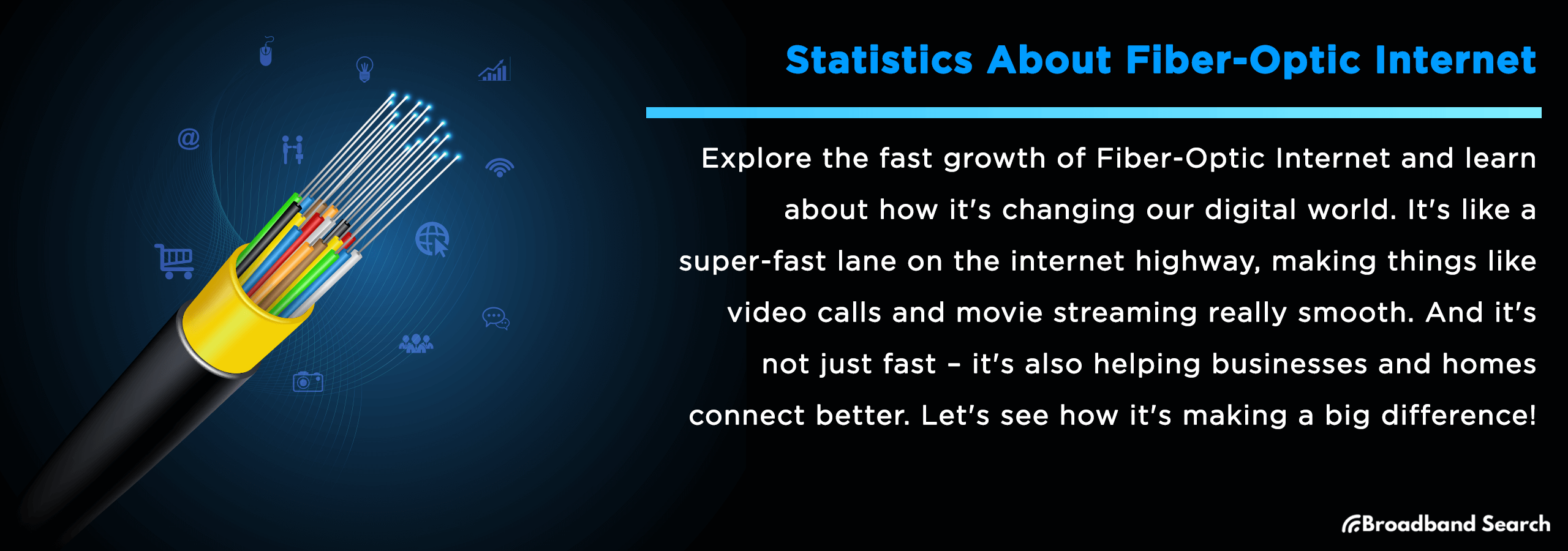Fiber-optic internet is pretty much changing the game when it comes to staying connected. It's like the express lane on the information highway, making everything from video calls to movie nights smooth sailing. WIth it, there are no concerns of buffering, lag, or anything of the sort.
But it's not just about speed. As we dive deeper, we'll see how this tech is not just speeding things up but also boosting economies and changing the way we access information. From businesses to your own living room, fiber-optic internet is reshaping our digital world. Let's explore how it's making a difference.
Global Adoption Rates
Overview of Global Fiber-Optic Adoption
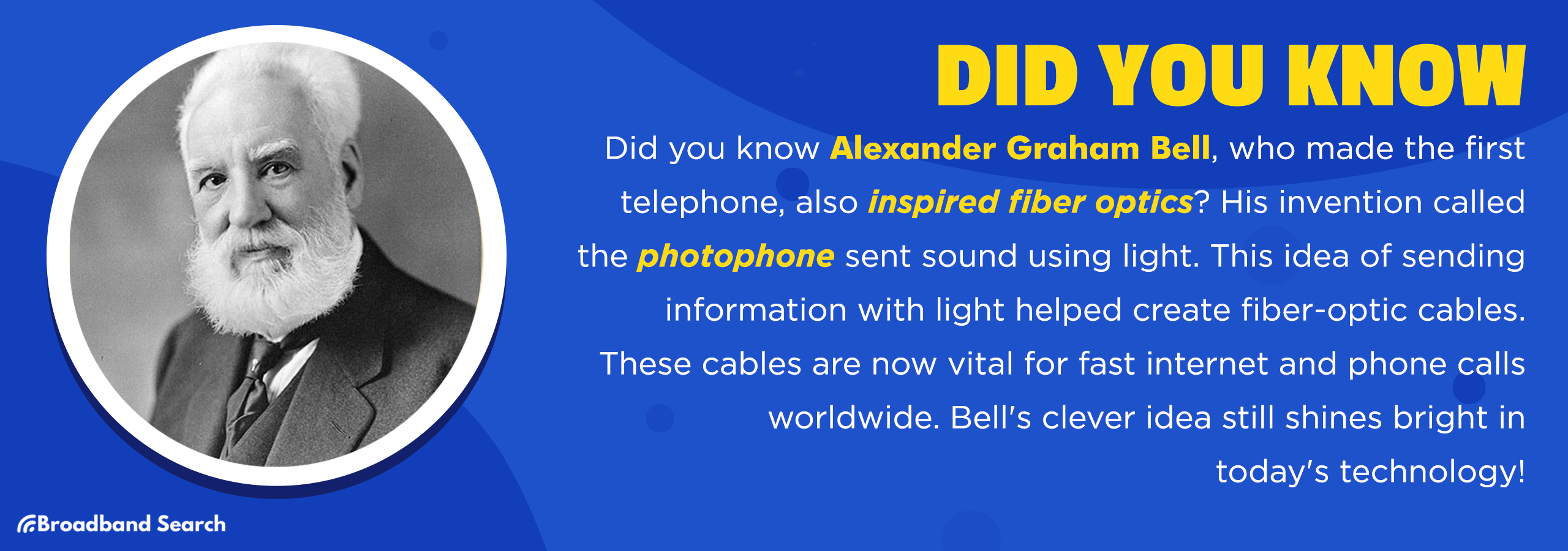
Originating in the late 19th century with roots tracing back to Alexander Graham Bell's photophone, fiber-optic technology has been revolutionized since the 1970s to transmit data via glass or plastic fibers at speeds nearing light. This advancement has significantly outpaced traditional copper cables. In 2023, Monaco achieved a landmark with 100% fiber-optic coverage, and Singapore boasted the fastest internet speeds globally.
Adoption Trends Over the Years
The annual growth rate of fiber-to-the-home (FTTH) connections is remarkable, especially in North America, where nine million new homes were connected in 2023 alone. Despite this growth, some areas, especially where fiber service is newly available, have seen flat adoption rates, hinting at potential market saturation or hesitancy in transitioning from legacy technologies.
Urban and rural areas show distinct differences in fiber-optic internet adoption:
- Urban areas enjoy higher access rates, with significant infrastructure already in place. As of June 2023, urban states showed an average fiber access rate of 67.2 percent, with a subscription rate of 13.5 percent.
- Rural areas, while lagging, exhibit a strong uptake where access is provided. Rural states had a 42.1 percent access rate with a 13.4 percent subscription rate by June 2023, indicating a high value placed on fiber access when available.
Regional Adoption Statistics
Adoption Rates by Continent
- North America: The adoption of fiber-optic internet in North America is characterized by significant growth, particularly in the United States, where fiber broadband now passes 51.5 percent of primary homes. In 2023, North America saw its highest annual FTTH growth, with nine million homes newly passed by network operators. Despite this, the region still faces challenges in labor availability and rising construction costs.
- Europe: The continent's fiber optics market is buoyed by multi-mode fiber optics, primarily due to its affordability and versatility, finding applications across various sectors, including healthcare, automotive, and telecommunications. This diversity in application underlines Europe's integrated approach to adopting fiber-optic technology.
- Asia: The Asia Pacific region leads the global market, with a revenue share of 28.8 percent in 2022, driven by technological advancements, widespread adoption in IT, telecommunications, and the development of fiber-integrated infrastructure. Countries like China, Japan, and India are propelling the market growth.
- Africa: Africa's adoption of fiber-optic internet is growing but remains hindered by infrastructure challenges and economic barriers. Efforts to increase fiber connectivity are underway, focusing on urban centers and gradually expanding to rural areas.
- South America: South America is gradually increasing its fiber-optic internet footprint, with countries investing in national broadband plans to expand access. Between 2021 and 2026, the market in the region will expand its FTTH network, doubling subscriber numbers and increasing homes passed by 150 percent.
- Oceania: In Oceania, countries like Australia and New Zealand have made significant strides in rolling out fiber-optic networks to urban and rural areas alike, aiming for comprehensive coverage.
Key Drivers of Adoption
- Government Policies: Governmental initiatives and investments play a pivotal role. For instance, in Asia Pacific and the U.S., governments are actively investing in improving national security infrastructures and supporting the deployment of broadband network platforms, fostering a conducive environment for fiber-optic growth.
- Economic Conditions: The affordability of fiber-optic solutions, especially multi-mode fiber optics due to its low cost and high bandwidth, is making it an attractive choice for a wide range of applications.
- Technological Infrastructure: The presence of robust technological infrastructure and the growing demand for high-speed, reliable internet for various applications, including cloud-based services and IoT, significantly influence the adoption rates. Regions with advanced IT and telecommunications sectors, like the Asia Pacific, witness higher adoption rates due to these factors.
Comparison with Other Technologies
When comparing fiber-optic internet to other broadband technologies such as DSL and cable, several key differences emerge, highlighting why fiber has become a preferred choice for many users seeking high-speed internet connections.
Fiber vs. DSL/Cable

- Speed: Fiber speeds range from 200 Mbps to 20 Gbps for both download and upload, offering symmetrical speeds that are ideal for heavy internet usage including streaming, gaming, and high-speed downloads. In contrast, DSL speeds can range from 5 to 120 Mbps for downloads and 1 to 20 Mbps for uploads, while cable internet typically provides 10 Mbps to 1 Gbps for downloads and 5 to 50 Mbps for uploads.
- Technology and Reliability: Fiber uses modern, high-speed cables made of fibers and glass, making it more resistant to interference and capable of delivering faster speeds over longer distances without signal degradation. DSL, on the other hand, operates on existing telephone lines, and cable utilizes coaxial copper wiring, both of which are older technologies and can be less reliable and slower, especially during peak usage times.
- User Preferences and Adoption Rates: Users increasingly prefer fiber due to its superior performance. This preference is reflected in the adoption rates, where fiber is expanding its footprint despite higher costs and currently limited coverage compared to DSL and cable. Providers like Verizon are focusing more on fiber and 5G, moving away from DSL, which has seen little to no technological advancements in recent years.
Impact of 5G and Wireless Technologies
- Coexistence with Fiber: 5G and fiber-optic internet can coexist and complement each other, with fiber providing the backbone infrastructure for 5G networks. The high-speed, low-latency capabilities of fiber are crucial for supporting the data backhaul needs of 5G networks, enabling them to deliver their promised performance.
- Competition: In some areas, especially urban and suburban regions with existing fiber infrastructure, 5G may compete directly with fiber-optic services by offering comparable speeds and lower latency without the need for physical connections to the home.
- Enhanced Connectivity in Rural Areas: Wireless technologies like 5G have the potential to extend high-speed internet access to rural and remote areas where deploying fiber-optic cables is not economically feasible. This could help bridge the digital divide by providing these areas with access to broadband speeds that were previously unavailable.
- Infrastructure Development: The rollout of 5G networks is driving demand for more fiber deployment, as fiber-optic cables are needed to connect 5G cell sites and ensure the network's capacity and speed requirements are met.
Country-wise Fiber Internet Speed Comparisons
Top Countries by Fiber Internet Speed
When exploring the landscape of global fiber-optic internet speeds, certain countries emerge as leaders, showcasing impressive broadband capabilities. These nations have invested heavily in their telecommunications infrastructure and demonstrate the significant impact of such advancements on internet speed and reliability.
Ranking and Statistics
- Singapore: Tops the charts with broadband speeds reaching an impressive average of 270.62 Mbps, showcasing its robust digital infrastructure.
- Hong Kong: Close on Singapore's heels, Hong Kong achieves broadband speeds of 266.63 Mbps, reflecting its advanced technological landscape.
- Monaco: This city-state shines with an average speed of 264.97 Mbps, underlining its commitment to top-tier digital infrastructure.
- Chile: Surprisingly leads in South America with broadband speeds of 256.67 Mbps on average, highlighting significant investment in fiber-optic technology.
- United Arab Emirates: Stands out in the Middle East with speeds of 235.72 Mbps, backed by substantial digital infrastructure development.
- China: With average broadband speeds of 256.32 Mbps, China demonstrates its commitment to expanding its digital footprint.
Analysis of Speed vs. Adoption
The correlation between high-speed internet availability and adoption rates varies by country, influenced by factors such as infrastructure development and policy support. Countries with the fastest internet speeds often have higher adoption rates.
However, there's a distinction between peak and average speeds; while peak speeds indicate a network's potential, average speeds reflect the actual user experience, which can be affected by network congestion and the spread of infrastructure.
US Regional Fiber Internet Speed Comparison
A closer look at specific states reveals a wide range of median download speeds.
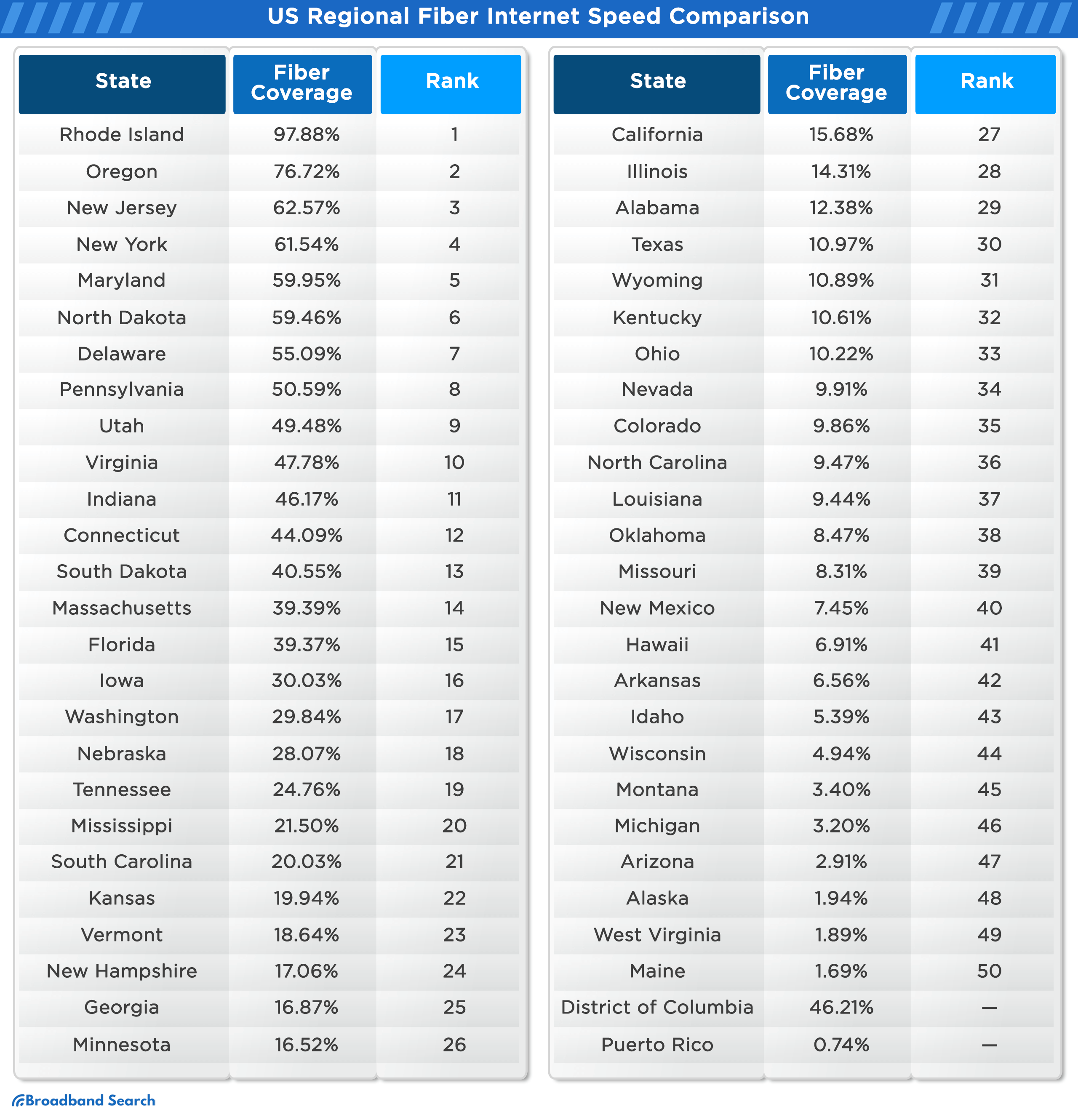
Urban vs. Rural Speed Disparities
Urban regions, with their dense populations and concentrated economic activities, often enjoy higher speeds due to economies of scale that justify the investment in fiber-optic infrastructure. In contrast, rural areas face challenges such as higher deployment costs over larger, less densely populated areas, and sometimes geographical barriers that complicate the extension of fiber networks.
Efforts to bridge this divide are underway, with initiatives focusing on expanding fiber-optic access to rural and underserved communities. These include federal and state-level funding programs aimed at supporting the build-out of necessary infrastructure. Additionally, technological advances like the deployment of low Earth orbit (LEO) satellites and the development of 6G mobile networks promise to enhance connectivity in remote areas.
Market Analysis
Market Size and Growth
The fiber-optic internet market is undergoing significant expansion and transformation, driven by the increasing demand for high-speed internet and advancements in telecommunications technology.
Current Market Valuation
The global fiber optics market is experiencing robust growth. Valued at USD 8.76 billion in 2022, it's forecasted to expand at a 6.9 percent CAGR from 2023 to 2030. Another report highlights the market attaining a value of USD 8.82 billion in 2023, with projections indicating a growth to USD 18.06 billion by 2032, reflecting an 8.30 percent CAGR. The market's expansion is fueled by the proliferation of digital technologies, including the evolution of 5G networks, which necessitates enhanced fiber optic infrastructure.
Market Share by Region and Provider
The Asia Pacific region commands the largest share of the global fiber optics market, attributed to extensive adoption in IT, telecommunications, and infrastructural developments, especially in China. North America, led by the United States, follows closely, benefiting from federal initiatives aimed at enhancing broadband connectivity, including rural and underserved areas. Europe is projected to be the fastest-growing region, driven by the demand for high-bandwidth communication and data services.
Several major companies dominate the fiber-optic internet market, each contributing to the industry's growth through innovation, expansion, and strategic initiatives:
- Corning Incorporated: A leader in the manufacture of fiber optic cables, known for their innovative solutions in telecommunications and various other industries.
- Prysmian Group: A global entity that specializes in cable systems for energy and telecommunications, offering a wide range of fiber optic solutions.
- Sumitomo Electric Industries, Ltd: This company is renowned for its contributions to the fiber optic market, providing cables and materials that support advanced telecommunication infrastructure.
- Sterlite Technologies Limited: Focuses on designing, building, and managing smarter digital networks, Sterlite plays a significant role in the fiber optic sector.
- Yangtze Optical Fiber and Cable Joint Stock Limited Company (YOFC): One of the largest providers of optical fiber, offering a broad portfolio of products for various applications.
Investment and Revenue Trends
Investment in Fiber-Optic Infrastructure
Investments in fiber-optic infrastructure are categorized into greenfield, acceleration, and mature markets. An estimated $253 billion is required for greenfield markets, which include regions with less than 30 percent household fiber access.
Acceleration markets, with 30-60 percent coverage, need about $131 billion to connect remaining households. Mature markets, where over 60 percent of households have fiber access, present a $39 billion opportunity, focusing on rural connections and upgrading hybrid networks.
The total investment needed across 87 countries is pegged at approximately $420 billion, underscoring the significant capital expenditure required to achieve comprehensive fiber connectivity.
Revenue Models and Profitability
The fiber-optic market's revenue models are intricately linked to the technological advancements and applications of fiber optics across various sectors, including healthcare, telecommunications, and information technology. The multi-mode fiber optic segment, due to its low cost and extensive application in the medical and automotive industries, held the largest revenue share in 2022.
On the other hand, the single-mode fiber optic segment is expected to see growth, driven by the demand for long-distance transmission applications. The plastic optic fiber (POF) segment is also anticipated to grow rapidly, attributed to its robustness and increased demand in consumer electronics.
- Healthcare: The application of fiber optics in minimally invasive surgeries and advanced medical treatments is driving demand within this sector.
- Telecommunications: Continuous advancements and the need for high-speed data transfer services bolster the adoption of fiber optics in this industry.
- Public Sector: Investments in infrastructure for improved national security and public services contribute to market growth.
- Energy and Utilities, Aerospace and Defence, and Manufacturing: These sectors leverage fiber optics for enhanced communication, safety, and operational efficiency.
Infrastructure Development
Expansion of Fiber-Optic Networks
In recent years, the expansion of fiber-optic networks has been monumental. With data demands skyrocketing, providers are racing to deploy fiber-optic infrastructure to meet the need for high-speed internet access.
Milestones in Network Expansion
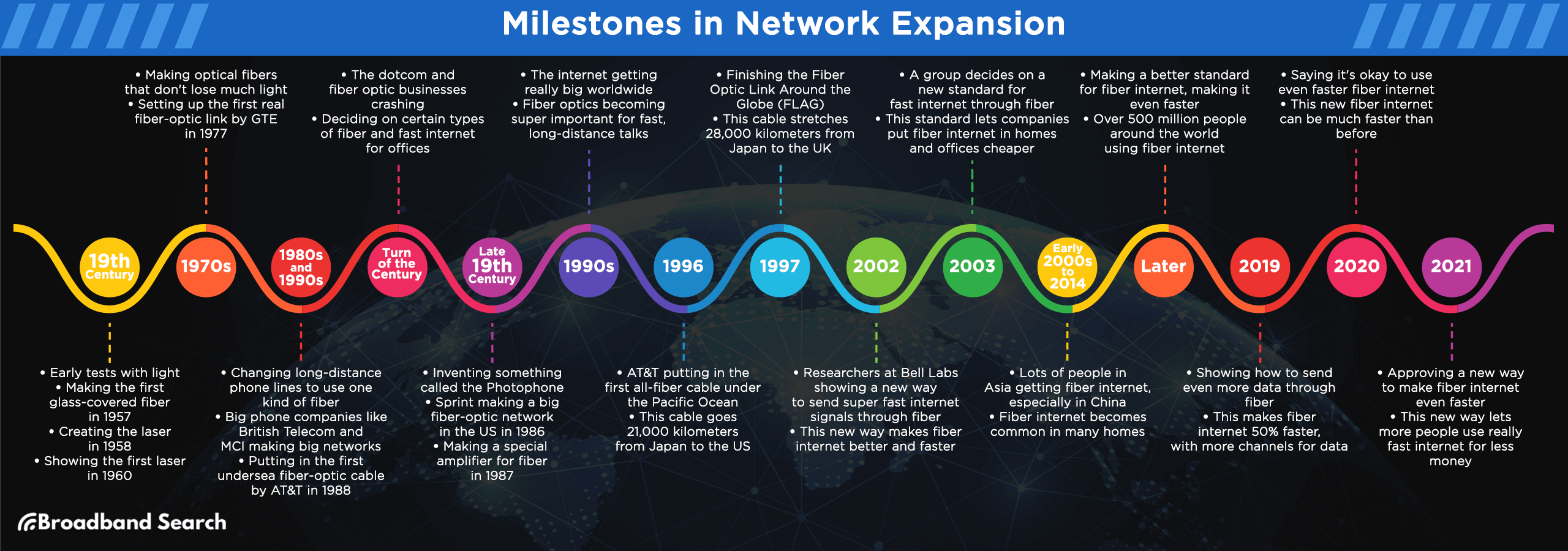
19th Century:
- Early experiments in light transmission
- Development of the first glass-clad fiber in 1957
- Invention of the laser in 1958
- Demonstration of the first laser in 1960
1970s:
- Creation of low-loss optical fibers
- Establishment of the first non-experimental fiber-optic link by GTE in 1977
1980s and 1990s:
- Conversion of long-haul telecom to single-mode fiber
- Launch of nationwide networks by British Telecom and MCI
- Introduction of the first transatlantic fiber-optic cable by AT&T in 1988
Turn of the Century:
- Dotcom/fiber optic bubble burst
- Standardization of OM3 multimode fiber and 10 Gigabit Ethernet for fiber LANs
Late 19th Century:
- Invention of the Photophone
- Establishment of the first nationwide fiber-optic network in the US by Sprint in 1986
- Invention of the erbium-doped fiber amplifier (EDFA) in 1987
1990s:
- Rise of the internet as a global network
- Fiber optics at the core of high-speed, long-distance communication
1996:
- AT&T lays first all-optic fiber cable across the Pacific Ocean
- Cable named TPC-5CN spanning 21,000 kilometers from Japan to the United States
1997:
- Completion of the Fiber Optic Link Around the Globe (FLAG)
- Infrastructure stretches 28,000 kilometers from Japan to the UK, showcasing fiber optics' ability to connect the world.
2002:
- Demonstration of Differential phase-shift keying (DPSK) for long-haul 40 Gbps fiber optic transmission by researchers at Bell Labs
- DPSK encodes data in phase change between adjacent bits rather than amplitude
- DPSK improves sensitivity by 3 dB compared to conventional on-off keying, increasing spectral efficiency and enabling higher capacities.
2003:
- Ratification of the gigabit-capable passive optical network (G-PON) standard by the International Telecommunication Union
- G-PON enables cost-effective fiber-to-the-premises deployment
- G-PON utilizes passive optical distribution network without active components, supporting data rates up to 2.5 Gbps downstream and 1.2 Gbps upstream
Early 2000s to 2014:
- Asia leads in G-PON adoption, with over 40 million subscribers in China alone by 2014
- G-PON delivers economies of scale for widespread residential fiber roll-out
Later:
- XG-PON standard upgrade boosts speeds to 10 Gbps down and 2.5 Gbps up
- PON networks exceed half a billion users globally, driving toward a fiber-connected world
2019:
- Demonstration of Super C-band transmission utilizing the extended 1527-1565 nm range
- Super C-band increases fiber capacity by 50 percent compared to traditional C-band
- Expansion to Super C-band accommodates up to 96 channels at 50 GHz spacing, compared to 64 channels in standard C-band
2020:
- Approval of 25G and 50G Ethernet passive optical network (EPON) standards by IEEE
- 25G EPON quadruples upstream speed to 25 Gbps downstream, while 50G EPON offers bidirectional 50 Gbps
- Backward compatibility with 10G EPON interfaces maintained, easing migration to higher speeds
2021:
- Approval of the 50G-PON standard by the International Telecommunication Union (ITU)
- 50G-PON delivers symmetrical 50 Gbps capabilities for next-generation PON access networks
- New technical capabilities include multiple wavelength bands, sliced spectrum, and flexible rate adaptation, enabling cost-effective delivery of 10Gbps and faster broadband services.
Government Initiatives and Private Investments
The United States, recognizing the need for a robust infrastructure, estimates a requirement of $130–$150 billion investment in fiber infrastructure over the next five to seven years to support broadband competition, rural coverage, and wireless densification. The Infrastructure Bill aims to eliminate barriers in underserved regions, catalyzing the expansion by addressing natural physical barriers and inconsistent regulations, which have historically impeded deployment in regions like the Midwest.
Technological Upgrades and Integration
The fiber-optic internet landscape is witnessing remarkable advancements and integration efforts, promising to revolutionize connectivity and data transmission across the globe.
Advancements in Fiber-Optic Technology
The evolution of fiber-optic technology continues to revolutionize global connectivity with groundbreaking developments. A notable advancement is a new fiber developed by the Japanese National Institute of Information and Communications Technology (NICT) and Sumitomo Electric Industries, Ltd. This fiber boasts 19 cores, significantly enhancing data transmission capabilities compared to traditional single-core fibers.
Macquarie University has contributed to this innovation by creating a 3D laser-printed glass chip that enables low-loss access to these multiple streams of light, ensuring compatibility with existing transmission equipment. This leap forward could dramatically increase the global internet's capacity, addressing the ever-growing demand for high-speed data communication.
Sustainability in Infrastructure Development
The global fiber optic components market is witnessing significant growth, driven by the advent of 5G network installations, government investments in fiber optic deployment, and the increasing establishment of data centers. Projected to grow from USD 22.43 billion in 2022 to USD 45.80 billion by 2030, this market's expansion highlights the critical role of fiber optics in modern telecommunications.
However, challenges such as the high cost of installation and the technology's susceptibility to physical damage remain. Opportunities for further growth lie in the improvements in edge computing, the Internet of Things (IoT), and advancements in cabling technology, pointing towards an era of more efficient and expansive fiber-optic networks.
Consumer Insights and Usage Statistics
Demographics of Fiber-Optic Internet Users
In 2021, the demographics of fiber-optic internet users showcase diversity, reflecting widespread appeal and increasing availability. Analysis delves into user specifics—age, location and occupation.
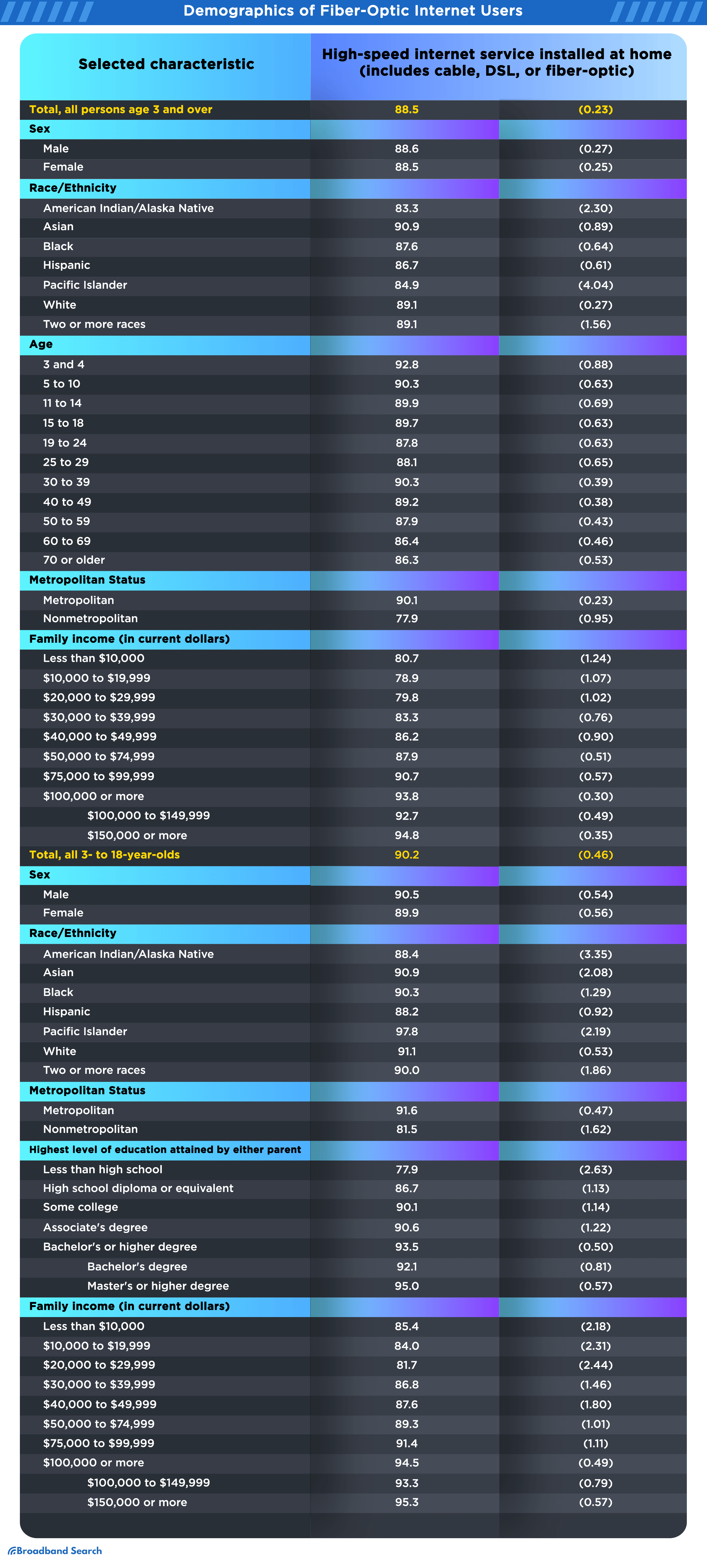
Purpose and Pattern of Usage
Fiber-optic internet is not just about faster browsing. It supports a wide range of applications, reflecting our diverse digital needs. Here are the top 5 common purposes for using fiber-optic internet, each backed by the latest insights:
- High-Definition Video Streaming: The demand for seamless streaming of high-definition content is one of the primary drivers of fiber-optic internet adoption. Services like Netflix and YouTube have become staples in entertainment, with Netflix boasting 238.39 million paid subscribers worldwide.
- Surgical Procedures: Fiber optic cables are prevalent in health and research, crucial for procedures like endoscopy, a minimally invasive surgery. Here, a compact, intense light illuminates internal sites, enabling surgeons to minimize incisions.
- Online Gaming and Esports: The low latency and high-speed capabilities of fiber-optic internet make it ideal for online gaming, where every millisecond counts. This ensures a smoother, lag-free gaming experience.
- Smart Home Devices: Fiber-optic internet facilitates the operation of smart home technologies, enhancing security and convenience.
- Remote Work and Video Conferencing: The pandemic has underscored the necessity of reliable internet for remote work. Fiber-optic internet supports video conferencing platforms like Zoom, which surged to 300 million daily participants, illustrating the critical role of high-speed internet in maintaining productivity and connection.
- Educational Purposes: The shift towards online learning platforms and resources necessitates robust internet connections. Fiber-optic internet supports live virtual classrooms, multimedia educational content, and the vast data needs of educational institutions.
- Remote Sensing: Fiber optic technology finds great utility in remote sensing, aiding scientists in gathering data from inaccessible locations. NASA employs this technology to study weather patterns on Earth, showcasing its versatility in data collection from remote environments.
Consumer Satisfaction and Service Quality
Understanding consumer satisfaction and the quality of fiber-optic internet service is crucial for grasping its impact on the market.
- Consumer Satisfaction Surveys: Recent findings from the American Consumer Satisfaction Index reveal AT&T, Lumen, and Google Fiber as leaders in fiber network customer satisfaction. This reflects a growing trend of preference for fiber-optic internet over traditional broadband solutions, underscoring the importance of customer experience in the sector. The overall satisfaction score for ISPs was 68, indicating room for improvement across the industry.
- Quality of Service Metrics: Key metrics like uptime, speed consistency, and customer service responsiveness are pivotal for consumer retention and acquisition. Verizon Fios showcases exceptional performance with high net promoter scores (NPS) and net loyalty intent (NLI), reflecting customer satisfaction. Conversely, other providers struggle with negative NPS scores. AT&T demonstrates significant progress with a notable 17-point increase in NPS from 2021.
Technological Advancements
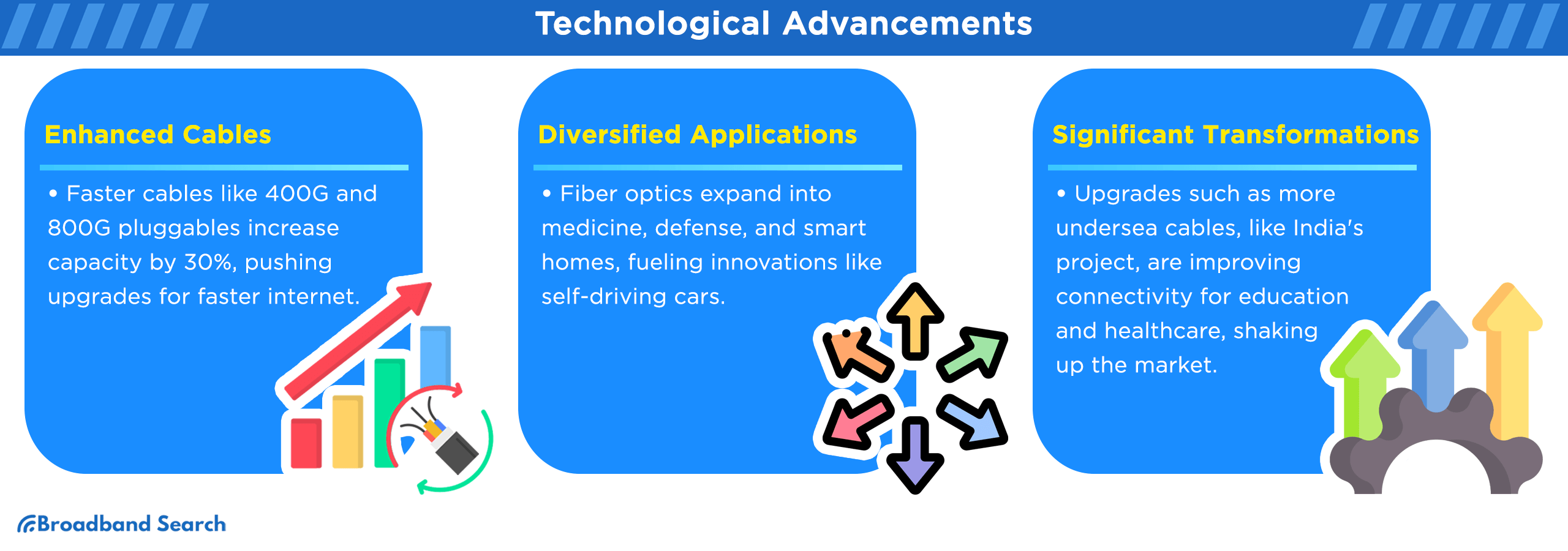
Innovations in Fiber-Optic Technology
Innovations like Dense Wavelength Division Multiplexing (DWDM), Fiber to the Home (FTTH), the emergence of new applications, and the integration of fiber-optic technology with cutting-edge fields such as IoT, AI, and smart cities are reshaping what's possible with internet connectivity.
- Developments in Cable Technology: In 2023, a surge in 400G and 800G pluggable deployments aimed to optimize fiber capacity and tackle spectral efficiency constraints defined by Claude Shannon. Innovations like Super C-band technology boost fiber capacity by nearly 30%, driving network operators towards newer optical line systems to harness this expansion effectively. These advancements signify significant progress in meeting the escalating demand for faster, more reliable internet connectivity.
- New Applications and Use Cases: Fiber-optic technology extends beyond traditional internet services, penetrating medical, military, and diverse sectors. Integration with 5G and expansion in smart home tech highlight its versatility. The fusion of 5G's network slicing and fiber-optic's speed enables ultra-fast applications like autonomous driving and remote surgeries. AI and machine learning enhance network management, elevating reliability and paving the way for unprecedented innovations.
Impact of Technological Advancements on Market Dynamics
Fiber-optic internet market undergoes transformative growth, driven by technological advancements, reshaping capabilities, competitive landscape, and consumer experiences. Innovation disrupts traditional dynamics, providing unprecedented speed, reliability, and efficiency.
- Disruption and Innovation: In recent years, the fiber-optic market has achieved notable milestones, such as deploying undersea cables to enhance network capacity and spectral efficiency. Initiatives like India's submarine optical fiber cable project have improved telecom connectivity, benefiting sectors like online education and telemedicine. These advancements underscore fiber optics' profound impact on market dynamics and consumer services.
Challenges and Opportunities
Identifying and Overcoming Challenges
The deployment of fiber-optic internet faces various challenges, from infrastructure and investment hurdles to market and regulatory barriers. However, with strategic approaches, these obstacles can be navigated successfully.
Infrastructure and Investment Challenges
The cost and complexity of fiber-optic infrastructure deployment are significant, especially in rural and underserved areas. Key strategies for overcoming these challenges include:
- Government Subsidies: Initiatives like the Federal Communications Commission's commitment to provide $2 billion in subsidies over the next decade aim to support broadband extension to rural areas.
- Public-Private Partnerships: These agreements between public entities and private companies help fund FTTH and FTTB projects, leveraging fast internet as an incentive for residential and commercial developments.
- Municipal Fiber Networks: Some communities are investing in their own fiber networks to attract businesses and improve local economies.
- Cooperative Action: Rural utility cooperatives are extending services to remote areas not served by large companies, significantly increasing access in places like Montana and North Dakota.
Market and Regulatory Challenges
Market barriers such as monopolies and regulatory hurdles also pose significant challenges to the widespread adoption of fiber-optic internet.
- Industry Support: Major corporations are investing heavily in digital infrastructure, aiming to reach underserved areas, albeit highlighting the need for more subsidies to complete these missions.
- Dig Once Policy: This policy lowers deployment expenses by coordinating roadwork and broadband installation, making the process more efficient and less costly.
- Organizational Support: Campaigns and advocacy platforms are pressuring governments to act more swiftly, especially in supporting American education and school systems with better connectivity.
Seizing Opportunities in the Fiber-Optic Market
As businesses and consumers alike seek more robust connectivity solutions, emerging markets and innovation present new avenues for growth and expansion.
Emerging Markets and New Consumer Segments
Opportunities abound in untapped markets and among new consumer demographics, especially in regions where the penetration of fiber-optic internet remains low.
- Partnerships with Local Providers: Collaborating with local telecom providers can offer a direct route to market, leveraging existing infrastructure and market knowledge.
- Government and Regulatory Engagement: Understanding and navigating the regulatory landscape is crucial. Engaging with local governments to influence and adapt to policy developments can facilitate smoother market entry.
- Customized Service Offerings: Tailoring offerings to meet the specific needs and preferences of local consumers can help differentiate in a new market.
- Infrastructure Investment: Direct investment in infrastructure, particularly in regions with underdeveloped internet services, can establish a long-term presence and market leadership.
- Community and Business Outreach: Building relationships with local communities and businesses can drive demand and foster brand loyalty.
Final Thoughts
In wrapping up our exploration of statistics about fiber-optic internet, we've uncovered a world of data reflecting its growing importance and widespread adoption. As the saying goes, "The numbers don't lie," and indeed, they reveal a compelling narrative of fiber-optic's pivotal role in shaping global connectivity.
Looking ahead, these statistics underscore the immense implications for the future of communication and technology. Stakeholders must heed the data, addressing challenges such as infrastructure expansion and accessibility while seizing opportunities for innovation and collaboration. Together, let's harness the power of fiber-optic internet to drive forward into a more connected and empowered world.
FAQ
Can fiber-optic internet speed be affected by weather conditions?
Fiber-optic internet is highly resilient to weather conditions. The cables are buried 3-4 feet deep, making them impervious to minor weather changes like rain, wind, and snow. However, extreme conditions like tornadoes could potentially cause damage to the network infrastructure, leading to disruptions.
Is fiber-optic internet available everywhere?
Fiber-optic internet is not available everywhere. Its deployment is more common in urban and suburban areas due to the high costs associated with laying fiber-optic cables. Availability depends on infrastructure development and investment by internet service providers in specific regions.
What are the environmental benefits of using fiber-optic internet?
Fiber-optic internet offers several environmental benefits over traditional copper networks, including higher energy efficiency and less resource depletion. It requires less power to transmit data over long distances and has a smaller ecological footprint due to its durability and longer lifespan.
Can fiber-optic internet bandwidth be shared or does it decrease with more users?
Fiber-optic internet provides a dedicated connection to users, which means bandwidth is not typically diminished by the addition of more users in the same service line. However, overall network congestion might still affect individual user speeds during peak usage times.
What is the lifespan of fiber-optic cables and what maintenance do they require?
Fiber-optic cables have a long lifespan, often exceeding 30 years under normal conditions. They require minimal maintenance compared to copper cables, mainly to protect against physical damage or to upgrade end-point technology to keep up with advancing speeds and capacities.

